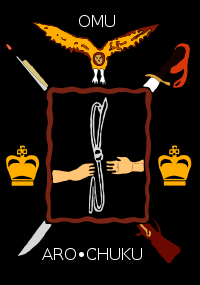Aro people
|
Flag of the Aro Confederacy | |
| Total population | |
|---|---|
| (Upwards of 1 million) | |
| Regions with significant populations | |
| Nigeria, Cameroon, Equatorial Guinea, Gabon, United Kingdom | |
| Languages | |
| Igbo, Ibibio, several Cross River languages | |
| Religion | |
| Christianity, Traditional | |
| Related ethnic groups | |
| Ibibio, Efik, Ekoi, Ijo, Igala, Idoma |
The Aro people or Aros are an Igbo subgroup[1] mixed with Akpa and Ibibio ancestry that originated from the Arochukwu kingdom in present-day Abia state, Nigeria. The Aros can also be found in about 250 other settlements mostly in the Southeastern Nigeria and adjacent areas. The Aros today are classified as Eastern or Cross River Igbos because of their location, mixed origins, culture, and dialect. Their god, Ibini Ukpabi, was a key factor in establishing the Aro Confederacy as a regional power in the Niger Delta and Southeastern Nigeria during the 18th and 19th centuries.
Origins and history
The history of the Aros predates Igbo migration and founding of the kingdom of Arochukwu. Before Igbos started arriving to the Aro region in the 17th century, Ibibios arrived from the Benue and plateau area and founded states such as Obong Okon Ita and Ibom west of the Cross River. Igbo migrations led by the Eze Agwu clan from the north into the Aro region started in the mid-17th century which led to tensions. The Aro-Ibibio wars and the migration of the Akpa from east of the Cross River, formed the nation during the turning point of the 17th century to the 18th century. The Igbo and Akpa alliance, defeated and assimilated the original Ibibio inhabitants after long years of warfare. By this time, the palm oil and slave trade was popular in the hinterland. By the mid-18th century, there were mass migrations of Aro businessmen to the Igbo hinterland and adjacent areas. This migration, influence of their god Ibini Ukpabi through priests, and their military power supported by alliances with several related neighboring Igbo and eastern Cross River militarized states (particularly Ohafia, Abam, Abiriba, Afikpo, Ekoi, etc.) quickly established the Aro Confederacy as a regional economic power. However, Aro economic hegemony was threatened by the penetration of Europeans, mainly British colonists towards the end of the 19th century. Tensions finally led to bloodshed, and the Anglo-Aro war took place from 1901 to 1902. The Aro Confederacy stoutly resisted but eventually suffered defeat. This helped the British to occupy the rest of what became Eastern Nigeria.
Tradition
The Aros have a rich tradition. One factor is the Ekpe society which is a sacred cult originally from east of the Cross River. The highly religious and judicial cult took a major part in Aro cultism. The use of the writing system, Nsibidi, was based on secret societies like Ekpe. Uli, another writing system, occurred mostly in the form of body art.
Another factor is the Ibini Ukpabi shrine, who was a mediating god among the Aros. They influenced neighbors and allies before the British invasion. The shrine was later corrupted, commercialized, and used for selling slaves during the slave trade. The Ekeleke masquerade activity was important in Aro settlements rather than Ekpe. Brought from the Aros in the western Niger Delta, it eventually spread to the Oguta area. They also were known for wearing the popular "George" cloth. The Ikperikpe warrior dance was very famous among warriors in the old days and continues to in use.
Largest settlements in Eastern Nigeria
- Aro Ajatakiri: In Ikwuano, Umuahia, Abia State
- Aro Achara: In Ama-asa, Isiala Ngwa, Abia State.
- Aro Umu Nkpe: In Isiala Ngwa, Abia State.
- Aro Nbawsi: In Isiala Ngwa, Abia State.
- Aro Omoba: In Isiala Ngwa, Abia State.
- Aro Okporoenyi: In Ikwuano area of Abia State.
- Aro Iyama: In Ikwuano, area of Abia State.
- Aro Amuru: In Ikwuano, area of Abia State.
- Aro Ndizuogu: Ideato area of Imo State (The biggest of all the settlements).
- Aro Ndi Ikerionwu: In Anambra State.
- Aro Ajalli: In Anambra State.
- Aro Nzerem: In Ebonyi State.
- Aro Amokwe: In Udi area of Enugu State.
- Aro Isuochi: In Abia State.
- Aro Isiokpo/Igwurita Ikwerre area in Rivers State.
- Aro Abagana: In Anambra State.
- Aro Oru: In Imo State.
- Aro Ngwa: In Abia State.
- Aro Ezeagu: In Enugu State.
- Aro Achi: In Enugu State.
- Aro Oboro Ite
- Aro Kalabari: In Rivers State.
- Aro Opobo: In Rivers State.
- Aro Uturu: In Abia State
- Aro Anwu Anwu: Eziukwu Durunnihe in Umudurunna ABBA Nwangele LGA Imo State.
See also
References
- ↑ Olson, James Stuart (1996). The Peoples of Africa: An Ethnohistorical Dictionary. Greenwood Publishing Group. p. 234. ISBN 0313279187.
- http://www.findarticles.com/p/articles/mi_m0438/is_1_35/ai_90331352/pg_5
- https://web.archive.org/web/20071009081317/http://www.aronetwork.org/others/ibini.html
- https://web.archive.org/web/20070322182431/http://www.aronetwork.org:80/others/index.htm
- https://web.archive.org/web/20060212061924/http://africanevents.com:80/AroChuku2003AnnualDinner.htm
